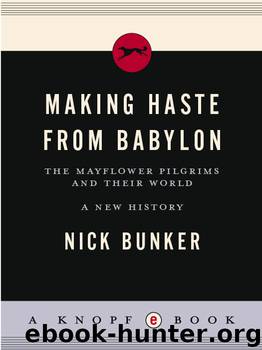Making Haste From Babylon

Author:Nick Bunker [Bunker, Nick]
Language: eng
Format: epub
Tags: History
ISBN: 9780307593009
Google: UznBt4ofE00C
Barnesnoble:
Goodreads: 8314335
Publisher: Knopf Doubleday Publishing Group
Published: 2010-04-13T10:00:00+00:00
CONVOYS TO RUSSIA
On October 20, 1621, boatmen on the Thames saw moored in the river five ships that had recently returned from the distant north. They came from the White Sea port of Archangel, six weeks away from London, and their journey there and back took them around the North Cape of Norway. The voyage to Arctic Russia was shorter by five hundred miles than the passage to America, but extreme cold, fog, the currents around the North Cape, and the danger of pack ice rendered it far more dangerous. It was undertaken for the sake of access to products that only Russia could supply.
On board, the five vessels carried the skins of hundreds of seals, ermines, and squirrels and that of a single wolverine. Most precious of all, on board a ship called the Encrease, were two thousand sable skins, imported by a man named Ralph Freeman. They made sable muffs, prized accessories since Queen Elizabeth ordered one of the first from Paris. For London’s hatters, Freeman brought home nearly four thousand beaver wombs, the segment of fur from the animal’s abdomen.14
Freeman was the uncrowned king of the fur trade. More than half the pelts that came into the Thames that autumn were his. He served his turn as lord mayor, he belonged to the board of the East India Company, and he invested in Virginia and Newfoundland. At his death Freeman left legacies equivalent to about eleven thousand acres of farmland. His supremacy in fur came about because, in 1620, he led a consortium that bought the exclusive rights to send ships back and forth from London to Archangel, rights that belonged to the Muscovy Company. With this deal, Freeman acquired complete control of English trade with Russia, and he kept it for the next decade, giving his rivals a new incentive to look westward across the Atlantic.15
From the moment that beaver hats became fashionable again, in the last quarter of the sixteenth century, a choice existed with regard to the source of pelts, and the principal countries concerned took different routes. The French went west. They obtained their skins from North America with a chain of supply that led from the St. Lawrence to the Louvre, by way of a royal hatmaker, based in the Rue de la Lingerie in the heart of Paris. In London, the haberdashers chose to take their skins from the east, from Archangel, but by the early 1620s this was becoming a less and less attractive option. A new source was necessary, even before Freeman made it essential to find an alternative.
Archangel was never an ideal trading partner. Ice closed the White Sea for eight months of the year, and so ships bound out from London would sail in convoy, between April and June, aiming to reach the port in time for its summer trade fair. They had to hurry back, or risk being trapped when the sea froze, and it was all too easy to stray out into the North Atlantic, or founder along the hazardous eastern coast of the British Isles.
Download
This site does not store any files on its server. We only index and link to content provided by other sites. Please contact the content providers to delete copyright contents if any and email us, we'll remove relevant links or contents immediately.
| Africa | Americas |
| Arctic & Antarctica | Asia |
| Australia & Oceania | Europe |
| Middle East | Russia |
| United States | World |
| Ancient Civilizations | Military |
| Historical Study & Educational Resources |
Making Haste From Babylon(713)
New York Burning by Jill Lepore(620)
An Inquiry Into the Nature and Causes of the Wealth of Nations by Adam Smith(596)
Braddock's March by Thomas E. Crocker(591)
Bunker Hill by Nathaniel Philbrick(579)
The Barbarous Years by Bernard Bailyn(480)
Commonwealth Caribbean Criminal Practice and Procedure by Dana S. Seetahal(467)
America's Revolutionary Mind by C. Bradley Thompson;(455)
John Adams Under Fire: The Founding Father's Fight for Justice in the Boston Massacre Murder Trial by Dan Abrams(451)
Bunker Hill: A City, a Siege, a Revolution by Nathaniel Philbrick(450)
Infamous Scribblers by Eric Burns(435)
American Slavery: A Very Short Introduction (Very Short Introductions) by Heather Andrea Williams(432)
A Land So Strange: The Epic Journey of Cabeza de Vaca by Andre Resendez(430)
The Wealth of Nations Books I-III by Adam Smith(427)
The City-State of Boston by Mark Peterson(423)
White Slavery In Colonial America: And Other Documented Facts Supressed from the Public Know! by Dee Masterson(422)
The Barbarous Years: The Peopling of British North America: The Conflict of Civilizations, 1600-1675 by Bernard Bailyn(417)
The First American by H.W. Brands(387)
George Washington by John Rhodehamel(376)
